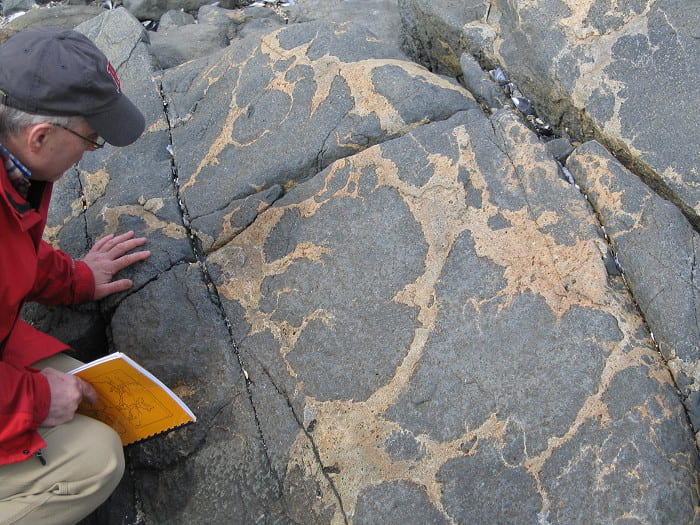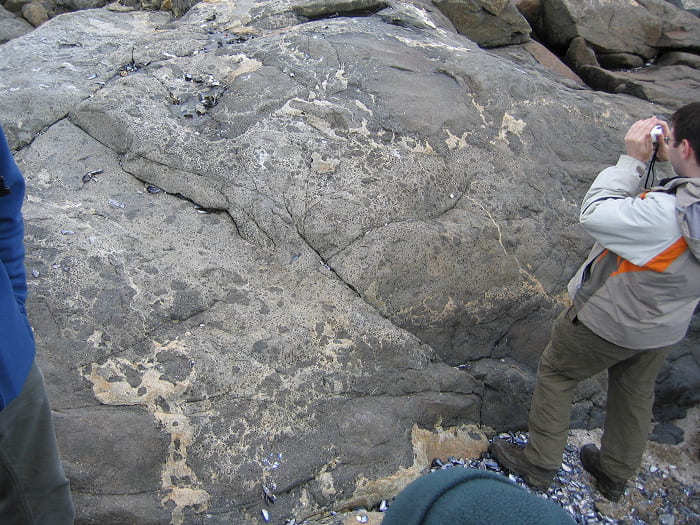Co-mingling of mafic magma with Beverly Syenite
The Beverly Syenite is supposed to be a quartz-poor variety of the Cape Ann Granite. It seems that all intermediates in quartz content can be found between granite and completely quartz-free syenite.

First, this is Beverly syenite. It consists mainly of perthite with minor quartz, and mafic minerals dominated by biotite. Some have suggested that this rock is of cumulate origin. As you can see, some of the feldspars are a centimeter or more across.

Here is a somewhat pegmatitic syenite dike cutting a medium-grained diorite or granodiorite, which also contains a mafic inclusion just to the right of the hammer point. The plot thickens.

This the second player at this locality, basaltic magma here crystallized to a fine-grained alkaline gabbro. This rock contains considerable amphibole and biotite. The light-colored part is a weathered surface, the dark part is fresh.

This is the a common, relatively simple co-mingling texture. The mafic blobs are surrounded by felsic rock. The mafic blobs look something like pillow lavas, and their rounded, lobate margins make it difficult to envision that they were once angular xenoliths, broken from solid rock surface into the felsic magma.

Here are more pillow-like blobs surrounded by felsic magma.

A close-up of one of the mafic blobs above. Like pillow lavas in water, this texture can be interpreted as a budding pillow that formed at a break in the chilled crust of the larger pillow, above, that may have been a few minutes older. Some of these pillows do, in fact, have fine-grained margins indicative of chilling. Remember that the basalt would have been injected into the felsic magma chamber at perhaps 1100-1150°C, and would quench against the rather dry felsic magma at perhaps 800-900°C.

Close-up of the lobate margins of some of the mafic blobs. Notice that the mafic blobs are full of plagioclase and dark mafic phenocrysts

So much for mingling, now for mixing, too. Here are some dark mafic blobs, white felsic rock, and a medium gray intermediate composition that, in some places, seems to partially or wholly grade into the white rock.

This is a close-up of the area in the image above. It shows thin layers of felsic rock between the mafic and medium-gray rock, parts of the gray rock apparently being extruded (upper right) between two of the mafic blobs, and apparent gradations in color and mineral content between the medium gray and white rocks (upper left).

This is a small blob of the felsic rock, apparently inside of a mafic blob. Notice the many dark blobs of different sizes in this felsic rock, features not generally found where the felsic rock occurs alone in large volumes. These may be bits of the mafic rock that have become mechanically incorporated into the felsic magma.

This is a closeup of some very fine lobate margins surrounding a large mafic blob. Notice that the mafic blob contains a felsic blob (top left), and that some white felsic rock is sandwiched between the mafic blob and a medium gray blob below it.

Here we see more typical xenoliths, but of quite a variety. There is a mafic xenolith in the felsic dike at the top of the image. There is a somewhat darker gray matrix to the dark blocks below, but some are fine-grained, some have variably straight or lobate margins, and some are coarse and more rounded. This is probably a mixed magmatic breccia, made up of broken pillows and other mafic fragments in a mixed magma matrix.

Here we have two layers of dark rock enclosing a layer of horribly inhomogeneous material. There is white rock that grades into darker gray mixed magma, with a variety of angular and round fragments. There is a large, horizontal, elongate, mottled medium-gray blob extending from the image middle to the right. This could be a squashed pillow, but because it seems to fill narrow fissures in the upper dark blob I think it was emplaced as liquid or, considering its mottled appearance, a slush of mixed dioritic liquid plus mafic lumps.

More inhomogeneous material, with mafic blocks and pillows, medium-gray blocks and blobs, in a matrix of variably contaminated felsic magma.

A fine dispersion of mafic and medium-gray lumps in a matrix of felsic magma.

A large, inhomogeneous mass of mixed medium gray dioritic rock, full of more mafic bits, surrounded by large mafic blobs and small remnants of less contaminated white magma.

Close-up of the top region of the image above, showing a profusion of mafic and less mafic blocks and blobs, in a variably medium-gray matrix.

This image is not so easy for me to interpret, but it shows a fine-grained gray matrix rock cut by a phenocrysts-rich mafic dike that contains small blobs of felsic rock. A thin dike above the large one, probably a contemporaneous offshoot, terminates against a continuation of the same open fracture that contains felsic rock. This thin dike therefore appears to have filled with felsic and mafic magma simultaneously as it opened.
